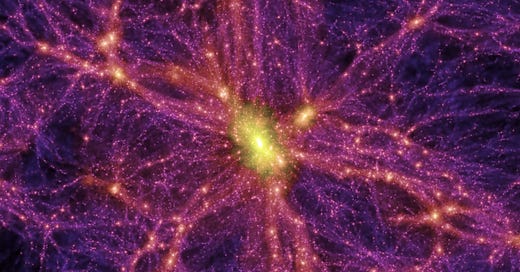Subscribe to the STEMScribe newsletter to gain full access to our materials. It’s free!
If you would like to submit a guest post to the blog, please fill out this form.
Introduction
Dark matter is one of the universe's most interesting mysteries. Dark matter, unlike the stars, planets, and galaxies that radiate light, cannot be seen and is only apparent by its gravitational effects. This unseen material accounts for approximately 27% of the universe while regular matter makes up only 5% of the universe. Understanding dark matter is essential for uncovering the mysteries of the universe's structure and evolution.
What is Dark Matter?
Dark matter is a form of matter that is thought to make up a large fraction of the universe's total mass. Despite its quantity, dark matter does not interact with electromagnetic forces, which means it does not absorb, reflect, or emit light. As a result, it is unseen and only discernible by its gravitational effects on visible matter, radiation, and the universe's overall structure.
Evidence for Dark Matter
Fritz Zwicky, a Swiss astronomer, introduced the concept of dark matter in the 1930s. Zwicky investigated the Coma Cluster of galaxies and discovered that the observable mass of the galaxies was insufficient to account for the gravitational forces that kept the cluster together. This implied the existence of unseen mass, which he called "dunkle Materie" or dark matter.
Research of galactic rotation curves provided additional data. Stars in galaxies, particularly spiral galaxies like the Milky Way, have been shown to rotate at speeds that cannot be explained by visible mass alone.
The Search for Dark Matter
Scientists have devised several methods to detect dark matter indirectly:
Gravitational Lensing: Dark matter can bend light from distant stars and galaxies, a phenomenon known as gravitational lensing. By studying these distortions, astronomers can map the distribution of dark matter in the universe.
The cosmic microwave background (CMB) is the afterglow of the Big Bang. Tiny variations in the CMB can reveal information about the amount and distribution of dark matter in the early cosmos.
Galaxy Clusters: Observations of galaxy clusters, the universe's largest gravitationally bound structures, show that visible matter alone cannot explain their mass. Dark matter must exist to explain the known gravitational effects.
Leading Theories
While dark matter remains undetected directly, several theories have been proposed regarding its composition:
WIMPs (Weakly Interacting Massive Particles): These hypothesized particles are among the most likely possibilities for dark matter. They only interact via gravity and weak nuclear force, making them difficult to detect.
Axions: Another candidate, axions are extremely light particles that have the ability to solve several theoretical issues in particle physics while accounting for dark matter.
Sterile Neutrinos: These are hypothetical particles that do not interact via the Standard Model's weak interactions, making them another potential dark matter candidate.
Conclusion
Among the most significant mysteries in contemporary astrophysics is still dark matter. It continues to challenge our understanding of the universe. Each new finding in the research promises to change our understanding of the universe by revealing more about this material. Dark matter remains an exciting frontier in the search for the answers to the universe's puzzles, regardless of whether it will be directly discovered in the near future or whether it will require new theories to grasp.
Written by Shaan Manchinasetty
The STEMScribe blog is a reader-supported publication. Subscribe to show your support. It’s free!
Consider spreading the word:



